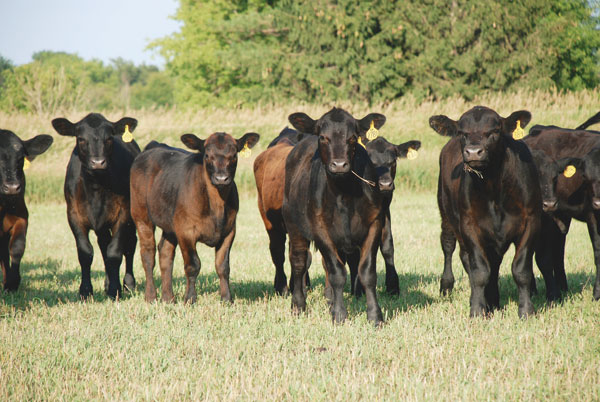Unfettered supply-driven price gains in the calf and feeder markets finally encountered some stiff headwinds last week.
April 9, 2012

Unfettered supply-driven price gains in the calf and feeder markets finally encountered some stiff headwinds last week. Resistance came from several directions, including negative outside markets, lower boxed beef values, seasonal price pressure, continued worries about beef demand overall, as well as concerns about the ultimate effect from the furor surrounding lean finely textured beef.
Feeder cattle and calves traded $4-$8/cwt. lower, with plenty of instances of as much as $15.cwt. lower for calves lighter than 500 lbs., according to the Agricultural Marketing Service (AMS).
“Grass interests are weakening and the grazing condition of the available calves is not as attractive to buyers,” explained the AMS reporter at St. Joseph Stockyards in Missouri Wednesday. “In addition, sharply lower cattle futures and higher grain prices have hit home…”
Cash fed cattle prices ended the week $3-$4/cwt. lower on a live basis ($123-$124) and a smooth $8/cwt. lower on a dressed basis ($192-$194).
“Continuing losses in the slaughter cattle market, accompanied with severe losses in the CME live cattle and feeder cattle board has put a very bleak forecast to the buying of feeder cattle,” said the AMS market reporter at Winter Livestock Feeder Cattle Auction in Dodge City Wednesday.
For perspective, week-to-week nearby Feeder Cattle (Apr-Aug) were down $2.55 in spot April to $3.82 lower in August. Nearby week-to-week Live Cattle futures (Apr-Aug) were down $4.17 in spot April to $2.72 lower in August.
“Feedlot managers were working with a positive basis of $4-$5 that helped make many of this week’s close-out pens reach their breakeven,” AMS analysts explained Friday. “The problem is that the alleys are full of cattle that wash in the mid $130’s, and the hope of feed cost relief does not appear to be developing.”
In fact, AMS analysts explain, “The events that released the trapdoor on this week’s feeder markets were largely the previous week’s USDA crop report that lowered quarterly corn stockpiles and the ensuing Chicago frenzy that sent nearby corn contracts up the limit and cattle futures down over $2.”
Packers continue drowning in red ink, too. Week-to-week, Choice boxed beef cutout values were down another $5.76/cwt. on the week; Select was another $7.10 lower. Worse, Choice boxed beef cutout values are $20.50/cwt. lower month-to-month and Select is $19.45/cwt. lower.
To be fair, Derrell Peel, Extension livestock marketing specialist at Oklahoma State University, points out the price of loins—the costliest primal in the carcass—is stronger than a year ago. Plus, Peel sees more reliance by retailers on the spot wholesale market, which he believes adds to the price volatility seen in that market in recent months.
Kevin Good, market analyst with Cattle-Fax, pointed out at last week’s annual meeting of the Texas and Southwest Cattle Raisers Association (TSCRA) that higher year-to-year net beef supplies are adding to the current dilemma. He explains higher net beef supplies are largely a product of slower export beef sales and increasing carcass weights.
However, Good noted that the significantly smaller supply of calves outside feedlots Jan. 1 suggests declining feedlot placements beginning in the second quarter and subsequently reduced fed cattle supplies.
Currently, though, Good pointed out record-high beef prices limit retailer ability to feature beef. He says retail beef featuring is running significantly below the three-year average as competing proteins leverage their comparative price advantage.
Conversely, food service continues to pick up steam.
According to the National Restaurant Association’s (NRA), increasing same-store sales and traffic are bolstering the optimism of restaurant operators. That organization’s National Restaurant Performance Index—a monthly composite index that tracks the health of and outlook for the U.S. restaurant industry—was up again in February.
“In addition, restaurant operators are bullish about sales growth in the months ahead, while their outlook for the economy remains cautiously optimistic,” explains Hudson Riehle, senior vice president of NRA's Research and Knowledge Group.
“Perhaps the most positive indicator is the optimistic outlook for staffing levels in the months ahead,” Riehle adds. “Only 7% of restaurant operators expect to reduce staffing levels in the next six months, the lowest level in nearly eight years.”
Jim Robb, director of the Livestock Marketing Information Center, says, “At these prices, consumers are careful buyers. For the last two years we’ve expected some consumers to trade away from beef, but it hasn’t happened yet.” Rather than turn away from beef, Robb believes consumers are figuring out ways to stretch further their beef purchases.
About the Author(s)
You May Also Like





